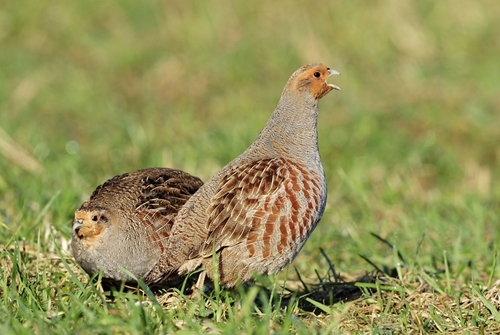Written by Phil Warren, Senior Research Scientist
3 Minute Read

Photo credit: Laurie Campbell
In the UK, grey partridges are primarily associated with lowland cereal farms and were common and widespread up until the Second World War. They have since undergone a severe population decline, chiefly linked to agricultural intensification, with numbers falling by 92% between 1970 and 2015. Combined with a range contraction of 40% between 1968-71 and 2007-11, the grey partridge has, as a consequence, been red-listed as a Bird of Conservation Concern.
Outside of the lowlands, grey partridges are also found on some sheep farms in the Pennine hills in northern England, where they frequent herb-rich meadows and rough grazing pastures infested with soft rush. Typically, these agriculturally Severely Disadvantaged Areas that host partridges are found on the edges of heather moorland used for driven red grouse shooting. This implies that less intensively managed farmland where predators are routinely controlled are important for partridges in the uplands. Here, our research has shown that over two-thirds of nests occur in tall cover provided by soft rushes. These rushes and associated coarse grasses host several species of sawflies, whose larvae are preferred by both grey partridge and black grouse chicks alike. Indeed, sawfly larvae comprise 46% of partridge chick diet in the first week after hatching.
Shooting bag data, together with repeated surveys comprising the Breeding Bird Atlas suggest that numbers and distribution of grey partridges on hill farms in northern England have recently declined. Our own annual counts illustrate that winter weather can strongly influence over-winter survival and subsequent population size the following spring. In the particularly severe winter of 2009/10, Teesdale partridges suffered high mortality when deep snow covered their seed and herbage food for 10 weeks, leaving many upper reaches of the dale devoid of birds.
Despite the passing of more than a decade, a succession of poor breeding seasons has been associated with partridges struggling to repopulate former habitats at higher elevations. At mid-altitude sites further down the dale birds persist, but at reduced densities. Here, annual spring call-back counts at dusk, combined with observations of broods in August and coveys in September have shown that partridges fluctuate in response to breeding seasons. Poor breeding has been strongly linked to wet and cool weather post-chick hatch in mid-June. Adverse weather can affect chick survival either directly through chilling, through reduced foraging time or through lowering invertebrate abundance.
A succession of poorer than average breeding years, followed by snow this last winter has reduced densities to an all-time low in our Teesdale study areas. Gamekeepers from upland estates in other North Pennine Dales have informed us of local extinctions among their wild greys, resulting in what is now a highly fragmented distribution. Similarly, while partridges were fairly common on the hill farms of the Ministry of Defence Training Area that comprised our Upland Predation Experiment at Otterburn in north Northumberland in the period 2000-08, a resurvey of the plots in 2018/19 found that none remained.
Immediate action may now be required to help retain remaining pockets of the upland partridge population in northern England. To do so, retention of rough grazings that maintain grass and rush mosaics through mixed sheep and cattle grazing, together with control of generalist predators, will be essential. However, these elements alone may not be enough and we encourage land managers to provide supplementary food to partridges in adverse winter conditions to help boost their survival and to potentially boost female condition going into the subsequent breeding season.
Filling this hungry-gap and thereby reducing winter mortality should mean that fewer chicks will need to be reared to maintain stable numbers. Ultimately, increasing the abundance of key insect foods such as sawfly larvae should help offset negative effects of poor weather. Currently we have insufficient knowledge about the needs of sawflies and hence factors that may influence their abundance. This forms an important knowledge gap to plug should we wish to retain wild grey partridges in the English uplands.